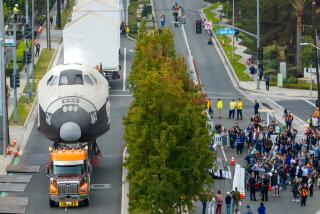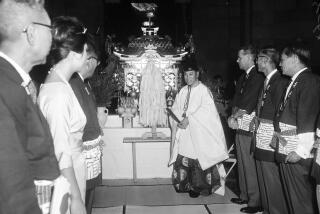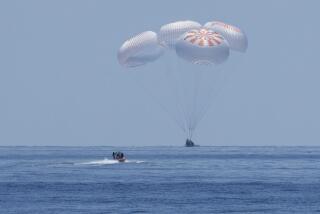Space shuttle Endeavour makes one more voyage to its final destination at a new space center
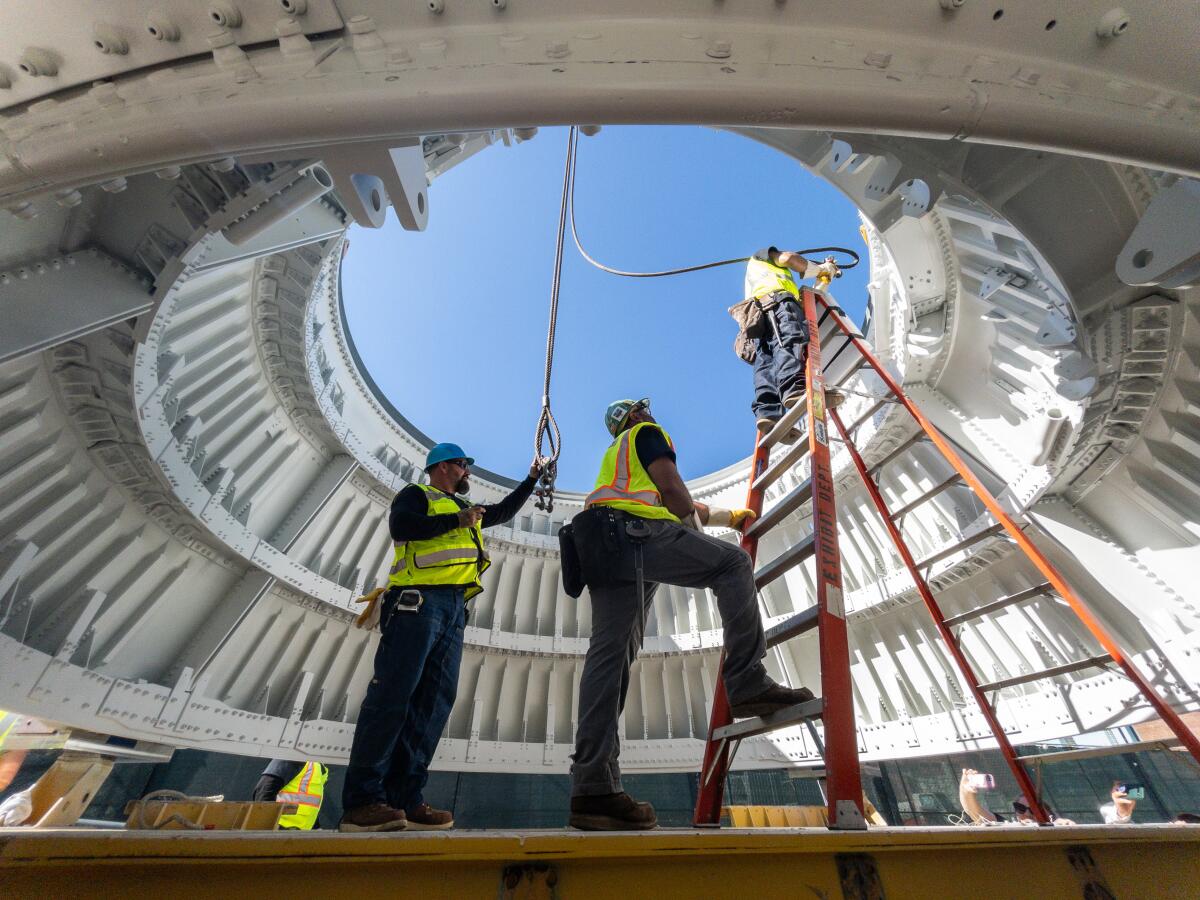
- Share via
The space shuttle Endeavour began the first part of its journey to its final resting place Thursday, an effort more than a decade in the making after arriving at the California Science Center museum in 2012.
The famed spacecraft that has been on horizontal display at the science center is in the process of moving to a permanent location in what will be the Samuel Oschin Air and Space Center, where the vehicle will be mounted in a vertical position, along with the solid rocket boosters and an orange external tank, making it look like it’s ready to launch. All four elements combined are called a shuttle’s full stack.
The new location will give guests views from multiple platforms, including from beneath the orbiter’s three main engines as well as from above, looking through a glass floor directly at its nose.
Endeavour flew 25 missions, with its first mission in 1992 and its last in 2011. In 2012, the Endeavour captivated people across California as it flew past the Golden Gate Bridge and Hollywood sign atop a Boeing 747, before it underwent a three-day trek on land over the 405 Freeway and across the streets of Los Angeles and Inglewood to its home at the California Science Center.
The move to the new space center is taking place in phases.
Workers lifted the base of the shuttle’s full stack, over the partially built walls of the future Samuel Oschin Air and Space Center, before placing it down onto a concrete slab that is supported with six seismic isolators. The entire weight of the space shuttle’s full stack will rest on what’s known as the aft skirts, the lowest part of the twin solid rocket boosters, which will support the weight of the entire space shuttle stack.
It took roughly two hours to move both skirts to the 1,800-ton concrete slab.
Jeff Rudolph, president and CEO of the California Science Center, said arranging the shuttle in a vertical position, as if ready to be launched into space, is a technically challenging process.
The margin of error for attaching the skirt is one-tenth of an inch, the width of a nickel.
“Anything beyond that will make the rest of the space shuttle stacking process impossible,” he said.

Once the position of the skirts are verified, they will be bolted down to the slab with four hold-down studs each.
Over the next six months or so, different parts of the shuttle’s full stack will be delicately placed and secured.
On top of the aft skirts — which weigh about 13,000 pounds — will be two solid rocket motors, which are being donated by Northrop Grumman and are being transported from Mojave to the science center sometime in October.
The forward assemblies will then be placed on top of the solid rocket motors to complete the solid rocket boosters.
After the solid rocket boosters are stacked, the 66,000-pound and 154-foot ET-94, an external tank currently at the California Science Center, will be lifted and attached to the boosters as early as January.
That same month, the rest of the Endeavour shuttle will make its trip from its temporary display at the center to be lifted and bolted to the external tank.
The full stack will be more than 200 feet tall.
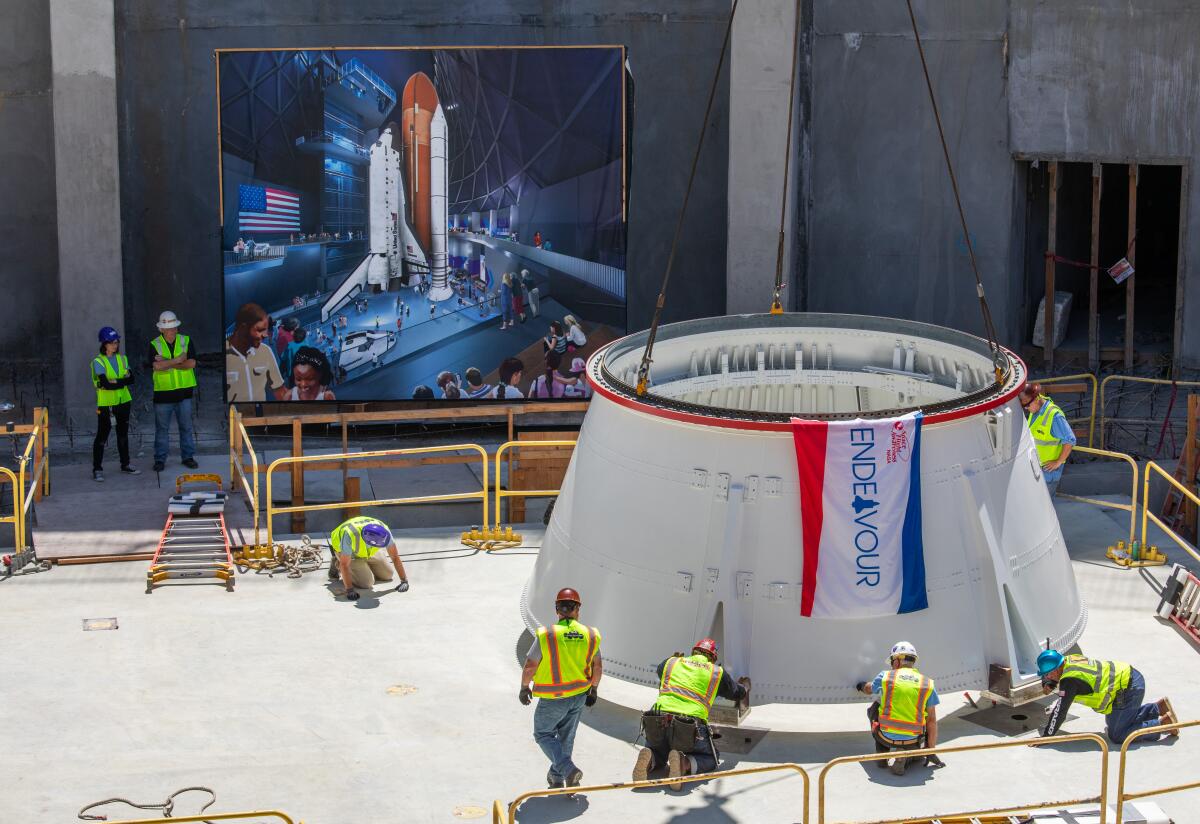
Museum guests will have until the end of the year to see Endeavour on display before it’s moved. This will be the last chance for guests to see the space shuttle up close for years before Endeavour will be on view again at the space center.
It could take at least three years before the new center will open to the public, said Ken Phillips, curator for aerospace science at the California Science Center. He said the building construction will take about two more years to complete and it could take at least an additional year to move other artifacts into the building.
As a way to protect the stack while construction of the new center continues, scaffolding will be built around it, which will be covered with plywood and Kevlar fabric.
Phillips said he hopes the space shuttle will inspire people, especially kids, to get involved with space exploration, aeronautics and exploring the universe.
“I want to see them walk through there, … and for them to know what an epiphany it is where you have this amazing insight and you think, ‘Oh wait a minute, I could actually do that. I could actually do that.’” Phillips said. “That’s what I’m looking for. I think it will truly be a transformational experience.”
Rudolph said there have been plans for more than 30 years to exhibit a full space shuttle in launch configuration, and now they are about to make that vision a reality.
“It’s pretty exciting to see this first step in fulfilling a decadeslong journey,” he said.
Times staff writer Rong-Gong Lin II contributed to this report.
More to Read
Sign up for Essential California
The most important California stories and recommendations in your inbox every morning.
You may occasionally receive promotional content from the Los Angeles Times.
